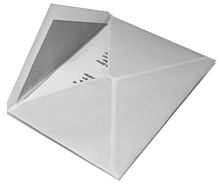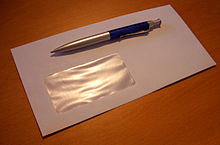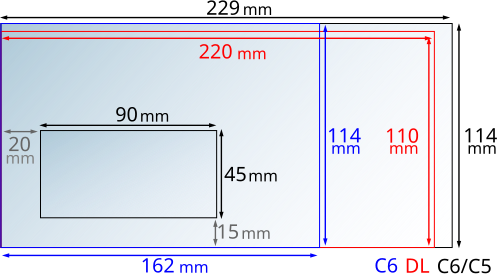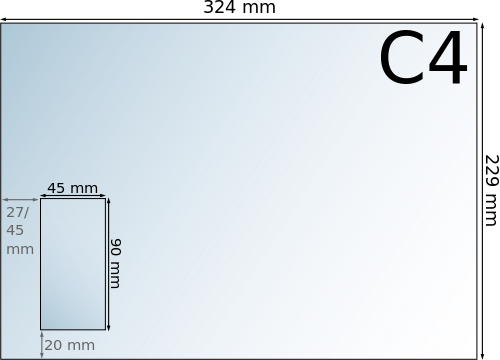Envelope
An envelope (also: envelope or, in Switzerland, envelope , outdated envelope ) is the shipping packaging for a letter .
history
Originally, letters were not packed in separate envelopes, but simply protected from unauthorized access by folding or rolling up and sealing . Often as folded letters , as paper was a valuable raw material. Later, in contrast to ready-made envelopes for inserting and sealing the letter, this became comparatively uneconomical. In today's postal correspondence, envelopes are used almost exclusively to protect the contents, with the exception of direct mail .
Envelopes were first sold in 1820 by the book and stationery retailer SK Brewer in Brighton . He cut the envelopes with the help of tin templates. In response to the rapidly growing demand, Brewer awarded the London company Dobbs & Comp. the order for the production of envelopes as mass-produced articles. The first machine for making envelopes was made by E. Hill and W. De La Rue, London , in 1844.
material
Envelope paper must be opaque, writable, printable and fold-resistant. It is made wood-free and containing wood, smooth or satined on one side, white and colored. But even recycled paper with the " Blue Angel " is used. Recently, FSC or PEFC papers, whose pulp comes from sustainable forestry, have increasingly been used for envelopes . Some FSC envelopes bear the logo of the WWF panda bear. There are also envelopes made from plastic fibers, from transparent or translucent film and from papyroline , a thread-reinforced material. Almost all the envelopes have a lock on the inside cover of rubber or two adhesive strips. Some envelopes have a window made of glassine or transparent plastic glued into the address area . The margins of the letterhead are also held together with adhesives.
production
First, starting from the paper roll, the inside and outside pressure of the envelope is applied using the flexographic printing process. Then the envelope silhouette is punched out, then the windowing takes place, and the window film is glued in. Then the side flap and the closure flap rubber coating are applied. After the sealing flap has dried, the envelopes are packed and then the finished boxes are packed on pallets using robots. Modern envelope machines produce up to 1,600 envelopes per minute or almost 100,000 per hour. Such systems cost more than two million euros. The most important manufacturers of the machines are Winkler + Dünnebier in Neuwied and FL Smithe in the United States; both companies belong to the Barry-Wehmiller Companies (USA).
recycling
Paper envelopes can be easily recycled. The waste paper used serves as a raw material for new recycled paper. The window foils used are made of glassine or polystyrene . They are separated out when the waste paper is deinking (decolorizing) and then also recycled or incinerated in the power stations of the paper mills. However, it is better to separate the window before disposing of it and dispose of it in the recycling bin, as this is the only way to achieve the desired flow of mono-materials and ensure recycling.
Sizes
Envelopes are mostly available in standard sizes. They are defined in ISO 269 and DIN 678 largely based on series C from DIN 476-2 or ISO 217 and series B from DIN EN ISO 216 or formerly DIN 476-1. The contents for C envelopes are A formats of the same number and for B envelopes the corresponding C formats, whereby the sheets can be brought to the next smaller format of the same series by folding them several times in the middle of the longer side. Standard envelopes therefore also predominantly have the usual aspect ratio of √2: 1.
Deviating from this, there are two formats with an aspect ratio of 2: 1 for differently folded pages. For format C6 / C5, the width of one format (C6) is combined with the length of the next larger format (C5). The unsystematic size of the DL format, colloquially "DIN long", is matched to the folded format for business letters according to DIN 5008 (and formerly DIN 676 ) of 210 mm × 105 mm, but also fits (without viewing window) to 1 ⁄ 3 A4 210 mm × 99 mm. The trade name “DL +” or “DIN long plus” as well as “C6 / 5” for C6 / C5 do not correspond to the standard and there is also no size “C5 / C6” or “C5 / 6”.
In addition, only the format of the largest standard letter envelope, E4, which lies roughly in the middle between B4 and A3, is not included in other DIN or ISO standards.
| format | B (mm) | L (mm) | L: B | Appropriate content |
|---|---|---|---|---|
| C6 | 114 | 162 | √2 | A6, A4 folded twice |
| B6 | 125 | 176 | √2 | C6 envelope |
| DL | 110 | 220 | 2 | 1 ⁄ 3 A4, A4 standard fold |
| C6 / C5 | 114 | 229 | 2 | 1 ⁄ 3 A4, A4 standard fold, DL |
| C5 | 162 | 229 | √2 | A5, A4 folded once |
| B5 | 176 | 250 | √2 | C5 envelope |
| C4 | 229 | 324 | √2 | A4 unfolded |
| B4 | 250 | 353 | √2 | C4 envelope |
| E4 | 280 | 400 | √2 | B4 envelope |
Envelopes in format C4 are not only produced in landscape format, but also in portrait format and then have a viewing window that fits the address field of unfolded business letters according to DIN 5008 on A4 paper. The formats C0 to C3 and C7 to C10 from DIN 476-2 have not been adopted in DIN 678-1, but occasionally at least envelopes in C3 format are offered.
For business letters on A4 paper format, the envelope formats DIN long (DL) with manual filling, C6 / C5 with machine filling and C4 are the most widespread in Germany. The C6 / C5 format is by far the most frequently used format in Germany and, according to DIN 678-2, is used alongside C4, C5 and C6 as an envelope for automatic enveloping.
Private mail is also often sent in C6 envelopes that can accommodate A6 greeting cards and postcards . Large and heavy goods are often sent in gusseted bags made of Kraft paper with side gussets and a block bottom in formats B5 to E4 ( mailing bags ).
| format | B (mm) | L (mm) | L: B | Appropriate content |
|---|---|---|---|---|
| DL + | 112 | 225 | 2 | 1 ⁄ 3 A4, A4 standard fold, DL |
| 120 | 235 | 2 | 1 ⁄ 3 A4, A4 standard fold, DL, C6 / C5 | |
| DL Max | 125 | 235 | 2 |
There are non-standard envelopes, for example, for greeting cards , which u. a. can be square.
| format | B (mm) | L (mm) | H (mm) | Weight | Postage (€) | C6, B6, DL, C6 / C5 | C5, B5, C4, B4 | E4 |
|---|---|---|---|---|---|---|---|---|
| Standard letter | 90-125 | 140-235 | ≤ 5 | ≤ 20 g | 0.80 | Yes | No | No |
| Compact letter | 70-125 | 100-235 | ≤ 10 | ≤ 50 g | 0.95 | Yes | No | No |
| Large letter | 70-250 | 100-353 | ≤ 20 | ≤ 500 g | 1.55 | Yes | Yes | No |
| Maxi letter | 70-250 | 100-353 | ≤ 50 | ≤ 1000 g | 2.70 | Yes | Yes | No |
| postcard | 90-125 | 140-235 | 150-500 g / m² | 0.60 | No | No | No |
Only size E4 is therefore outside the limits defined for letter post and must be sent as a parcel or parcel accordingly. The maximum size for large letters and maxi letters corresponds exactly to format B4.
Size and position of the windows
There are several different standards for window envelope dimensions.
Germany
DIN 680 results in different distances between the viewing window and the upper edge, depending on the format, so that a letterhead according to DIN 5008 must be folded exactly in order to place the address field in the viewing window:
For larger mailers, there are two forms A and B corresponding to the letterheads for business letters Form A and B according to DIN 5008, since the position of the address field can no longer be adjusted here by folding the letter. In the case of C5 envelopes, the window is also 45 mm × 90 mm in size and 20 mm from the left edge, 77 mm from the bottom for form A and 60 mm for form B. With C4 envelopes, the clearance of the letter in the envelope is much greater, especially in the direction of the longer edge, so the window must be larger. It is 55 mm × 90 mm and 20 mm from the left edge, 40 mm from the top for form A and 57 mm for form B.
Switzerland
In Switzerland there are also Swiss Post requirements for letter design and the placement of the address field.
Great Britain
The British standard BS 4264 defines a 39 mm high and 93 mm wide viewing window for the DL format, which is 53 mm from the upper edge and 20 mm from the left edge.
inscription
The German Post expects the marked parallel to the longer side of the viewing window or the envelope, the postage in a 40 mm high and 74 mm wide field at the top right, the address of the sender in the 40 mm high strip to its left and the address of the addressee in the remaining region at least 15 mm from the outer edge. The destination code is printed in the area below the address .
The Austrian Post expects, furthermore, that the area is kept below the 74 mm wide franking and larger sizes, a 74 mm high area at the bottom in the format C5.
Royal Mail expects that two fields will be kept free in a 70 mm high and 140 mm wide area at the bottom right and that the address of the sender will be placed on the rear flap.
The Swiss Post provides a large number of variants.
use
Envelopes are sealed by gluing the slightly overlapping, folded-over open side (flap for short) to the envelope. Either dry, water-soluble adhesive is used, which is moistened when closing, or they are self-adhesive. The blue glow when a self-adhesive closure is opened is called triboluminescence . In the case of high-quality envelopes, adhesive bonding with cover strips is often used. The latter are mainly used for high quality business mail. The name and address of the addressee are written on the front of the envelope, the information about the sender is usually written on the back or on the top left of the front.
Window envelopes are also often used in the business sector, in which the address of the addressee is not written on the envelope, but the letter with the address in the letterhead is placed in the envelope so that the address is visible through the window, for example in accordance with DIN 5008 . There are different types of folds for the different envelopes so that the addresses are visible in the window. Window envelopes are usually printed or stamped with the sender information either on the front or above the address on the letterhead so that they are visible in the window.
market
According to the Association of German Envelope Manufacturers (VDBF), around 13 billion envelopes, mailer and gusset bags are currently produced in Germany (as of 2019). Less than 10 billion envelopes are still sold in Germany, and the trend is continuing to decline. The market has fallen sharply in the last 10 years, as electronic media are increasingly replacing envelopes for sending invoices. Sales envelopes have also lost a lot of their importance in recent years. Large-format mailing and folding bags, on the other hand, were more able to benefit from the new Internet medium.
In Europe, around 46 billion envelopes are sold annually (as of 2019), which corresponds to a decrease of almost 60% in 10 years.
In Germany, the two most important manufacturers are the Mayer-Kuvert and Bong group of companies . At the European level there are also Tompla (E), La Couronne (F), GPV (F), Nova Kuverta (SLO), Blasetti (I), ELCO (CH) and Goessler Kuverts (CH), which together have a total market share of represent approximately 90%.
Multiple envelopes
A special form of the envelope is in the internal increasingly used reusable correspondence interoffice mail envelope .
On these envelopes you will usually find a kind of table in which the sender, the date and the recipient are entered.
There are also holes that allow a quick inspection of whether there are documents or the like in the envelope. They are mainly closed with a string closure.
Envelope with tear cord
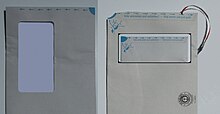
The small window on the right envelope shows the print before opening.
Patented envelopes offer a clean opening of the letter without tools . At the edge the envelope is perforated on the "thumb grip area" , by tearing this small piece of paper a "tear-off cord" (" Zipp-o-let " / English pull tab ) is cut out at the edge, which opens the envelope with it. This technique is z. B. has long been common in cigarette packaging with clear film .
Web links
Individual evidence
- ↑ Maurice Rickards, Michael Twyman: The encyclopedia of ephemera: A Guide to the Fragmentary Documents of Everyday Life for the Collector, Curator and Historian, Publisher: Routledge Chapman & Hall; Edition: illustrated edition (December 2000), pages 135 to 137.
- ↑ a b envelope. In: Wolfram Grallert: Lexicon of Philately. 2nd Edition. Phil * Creativ GmbH, Schwalmtal 2007, ISBN 978-3-932198-38-0 , page 75.
- ↑ a b Brewer. In: Wolfram Grallert: Lexicon of Philately. 2nd Edition. Phil * Creativ GmbH, Schwalmtal 2007, ISBN 978-3-932198-38-0 , page 66.
- ↑ Disposing of paper correctly is more difficult than expected. In: oekofreaks. Retrieved April 29, 2019 (German).
- ↑ DIN C4. Press and Information Office of the Federal Government, accessed on January 29, 2016 .
- ↑ a b Markus Kuhn: International standard paper sizes. Retrieved March 18, 2010 .
- ↑ Letter design according to the requirements of the Post. Post CH AG, accessed on January 30, 2019 (Swiss Standard German).
- ↑ Automation-capable letters. (PDF; 5.26 MB) Deutsche Post AG , accessed on July 11, 2016 .
- ↑ Correct addressing. (PDF; 2.06 MB) Austrian Post, accessed on April 8, 2010 .
- ↑ A guide for letter envelope design and clear addressing. (PDF; 601 kB) (No longer available online.) Royal Mail, archived from the original on October 31, 2014 ; Retrieved June 20, 2016 . Info: The archive link was inserted automatically and has not yet been checked. Please check the original and archive link according to the instructions and then remove this notice.
- ↑ Large Letter mail. (PDF; 492 kB) Royal Mail, accessed on March 8, 2010 .
- ↑ letters. (PDF; 3.37 MB) Swiss Post, accessed on September 21, 2011 .
- ↑ Key figures of the envelope manufacturers in Germany. In: Association of the German envelope industry eV (VDBF). 2019, accessed July 22, 2019 .
- ↑ European Patent No. 0 683 748; USA Patent No. 5,984,170; International registration for “ Zipp-o-let ” No. 641 250; German utility model No. 295 00 983.7
